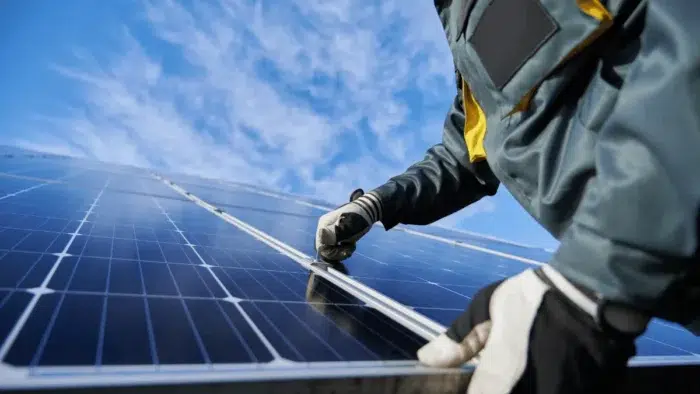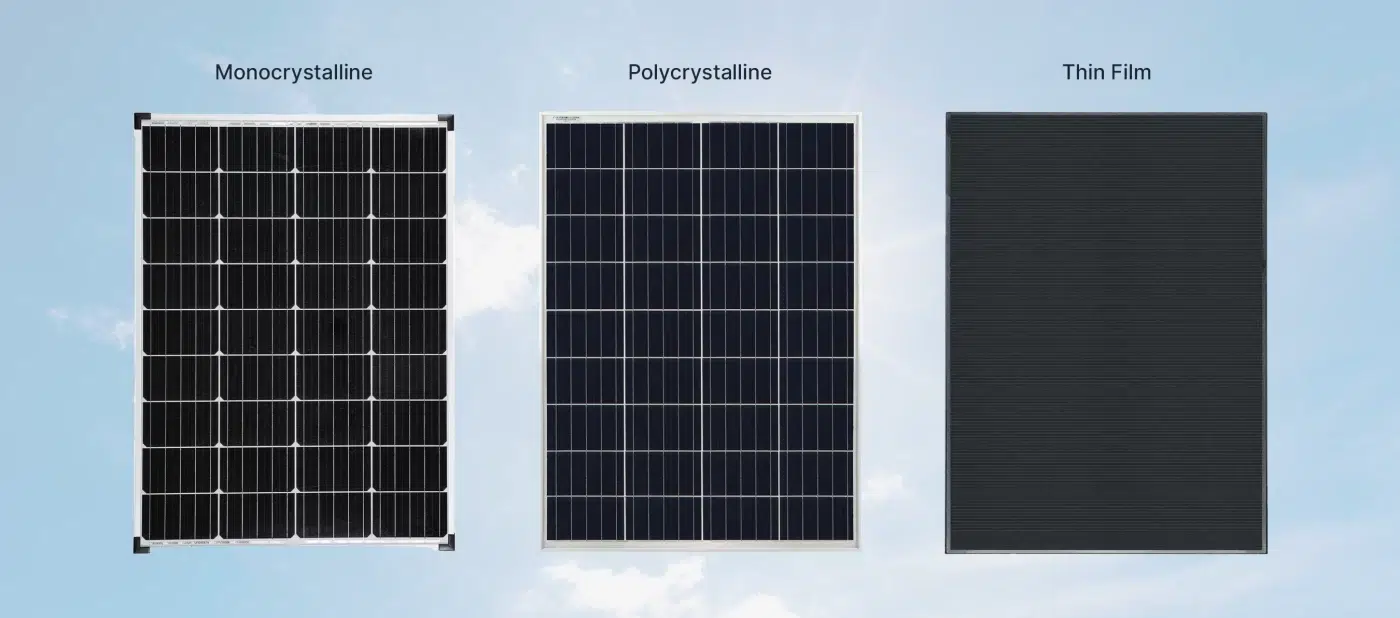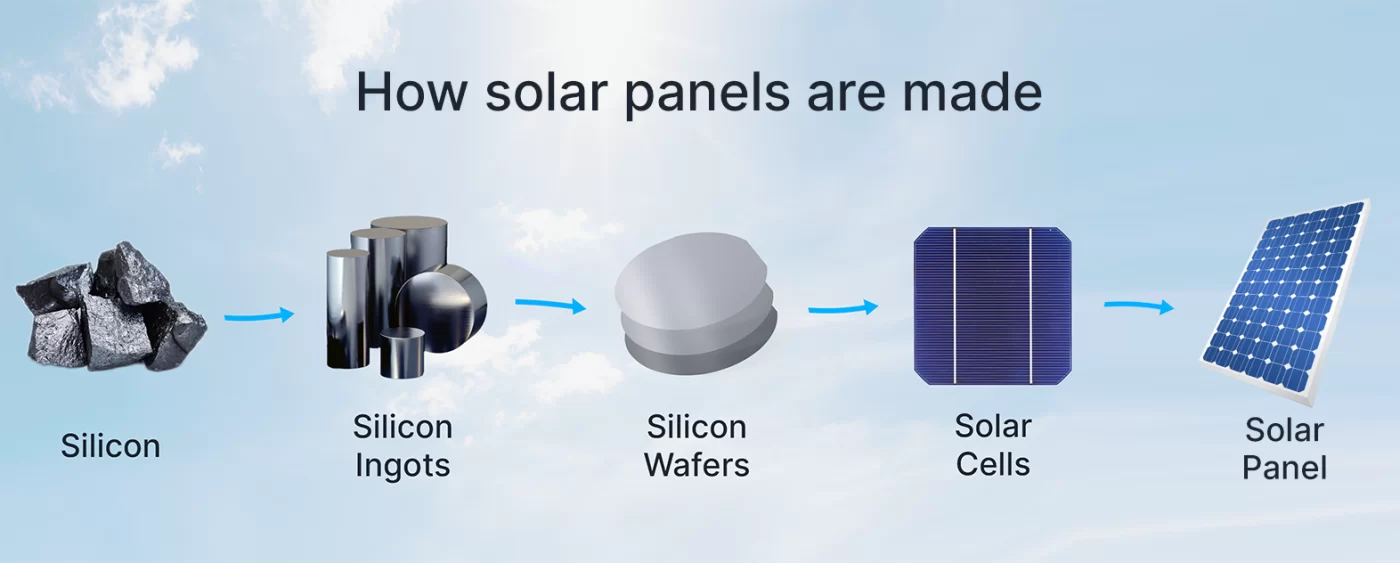Sonnenkollektoren übernehmen die schwierige Aufgabe, Sonnenenergie aus der Sonne zu erzeugen, Aber sie in einer gut geführten Fabrik herzustellen ist ziemlich einfach. Solarmodule bestehen aus Solarzellen, Silizium, Metall und Glas. Jede dieser Komponenten wird dann zu einem Solarpanel zusammengebaut, das nachhaltige Energie erzeugen kann.
Lassen Sie sich von uns durch die Einzelheiten der Herstellung von Solarmodulen führen, Wo werden Solarmodule hergestellt und woraus werden Solarmodule hergestellt, bevor sie von einem Auftragnehmer geliefert und auf Ihrem Dach installiert werden?.

Wo werden Solarmodule hergestellt??
Von den USA nach Europa, Es gibt zahlreiche Hersteller von Solarmodulen, Aber die überwiegende Mehrheit der Solarmodule wird in Asien hergestellt. In den vergangenen Jahren, Die Auslagerung der Fertigung in Länder mit niedrigeren Arbeitskosten ist in vielen Branchen zur Standardpraxis geworden.
Trotzdem, Viele hochwertige Panels werden in den Vereinigten Staaten hergestellt, So kann die Qualität in jeder Produktionsphase streng kontrolliert werden.
Schauen wir uns einige Beispiele von Solarmodulen an, um deren Produktionsstandorte zu verstehen. Panasonic Und Mission Solar sind beides Premiummarken. Panasonic Solarmodule werden in den USA und Malaysia hergestellt, während Mission Solar-Module nur in den Vereinigten Staaten hergestellt werden.
Jinko Solar ist ein billigerer Hersteller von Solarmodulen als Panasonic oder Mission Solar, Herstellung von Solarmodulen in China. Solar Power ist ein weniger bekanntes Unternehmen, das Module in Kanada herstellt.
Denn Lieferketten können sich über mehrere Länder erstrecken, Nicht alle Komponenten eines Solarmoduls werden immer am selben Standort hergestellt. Während Solarmodule weltweit hergestellt werden, Es gibt auch viele Optionen, die in den Vereinigten Staaten hergestellt werden.
Woraus bestehen Sonnenkollektoren??
Auf der grundlegendsten Ebene, Photovoltaik-Solarzellen, Polysilizium oder Silizium, Metall und Glas sind die Schlüsselkomponenten von Solarmodulen. Solarzellen wandeln Sonnenlicht in nutzbare Energie um und sind der wichtigste Baustein. Solarzellen sind Photovoltaik (PV) Komponenten von Solarmodulen, Das heißt, sie produzieren Sonnenenergie.
Solarzellen bestehen aus Silizium und sind durch eine Glasschicht abgeschirmt, die das Sonnenlicht auf die Zelle eindringen lässt. Bei Sonneneinstrahlung, Die Solar-Silica-Zelle erzeugt einen elektrischen Strom, Dieser wird anschließend von einem Wechselrichter in nutzbaren Wechselstrom umgewandelt.
Solarzellen werden mit Hilfe von Drähten gebaut. Die Verkabelung ist mit der Batterie verschweißt, die dann zwischen der schützenden Rückwandplatine und dem Glas platziert wird. Ein Metallrahmen hält das gesamte Panel zusammen.
Was sind die 3 Arten von Solarmodulen?

Solarmodule werden hauptsächlich in drei Typen unterteilt: Einkristall, Polykristall und dünner Film.
Einkristall-Solarzellen werden aus Einkristallen geschnitten. Diese Kristalle werden durch einen streng kontrollierten Prozess aus geschmolzenem Silizium gezüchtet. Der Unterschied zu polykristallinen Siliziumplatten besteht darin, dass polykristalline Siliziumplatten durch die Verschmelzung vieler Siliziumkristalle hergestellt werden, ein Prozess, der nicht die Züchtung von Einkristallen aus geschmolzenem Silizium erfordert.
Aufgrund der Verwendung von monokristallinem Silizium, Monokristalline Panels sind effizienter als polykristalline Panels, aber sie sind auch teurer. Die Hauptunterschiede liegen im ästhetischen Reiz, Kosten und Effizienz, Aber beide Optionen sind eine ausgezeichnete Wahl für eine Solaranlage für Privathaushalte.
Aufgrund ihrer sehr geringen Effizienz, Dünnschicht-Solarmodule werden hauptsächlich für Großprojekte in der Solarindustrie eingesetzt. daher, Zur Stromerzeugung wird eine große Menge Strom benötigt. Im Gegensatz zu monokristallinen und polykristallinen Panels, Dünnschichtplatten bestehen nicht aus Solarzellen, Sie werden jedoch durch Aufbringen einer dünnen Schicht photovoltaischen Materials hergestellt (wie amorphes Silizium oder Cadmiumtellurid) auf eine feste Untergrundoberfläche auftragen (wie Glas).
Dünnschicht-Solarmodule werden in Solaranlagen für Privathaushalte nicht verwendet, da sie nicht so stark und effizient sind wie herkömmliche Module.
Die technischen Details der Herstellung von Solarmodulen sind komplex, und wir beschreiben jeden Schritt des Prozesses in den folgenden Abschnitten. Die folgenden Schritte gelten für kristalline Silizium-Solarmodule, die mehr ausmachen als 90% des globalen Marktes. Andere Paneltypen, einschließlich Dünnschichtplatten, haben je nach Material unterschiedliche Herstellungsverfahren.
Wie werden Solarmodule hergestellt??

Schritt 1: Gewinnung und Raffination von Silizium
Silizium ist das zweithäufigste Element in der Erdkruste, nach Sauerstoff, ausmachen 27.7% der Erdkruste. Jedoch, Natürlich vorkommendes Silizium verbindet sich mit anderen Elementen wie Sauerstoff, Phosphor, und Stickstoff. Um Silizium zur Erzeugung von Solarenergie zu nutzen, es muss zunächst einem Reinigungsprozess unterzogen werden. In diesem Stadium, Das Silizium liegt in Form von Sand oder Kieselsäure vor, normalerweise aus zerkleinertem Quarzit hergestellt.
Der Sauerstoffgehalt in mineralischem Siliciumdioxid kann durch hohe Temperaturen entfernt werden, Das Ergebnis ist hochreines Silizium. Die Solarindustrie nutzt 99.9999% reines Polysilizium zur Herstellung sowohl polykristalliner als auch einkristalliner Solarzellen. Einkristalline Solarpanelzellen werden aus einem einzelnen Siliziumkristall hergestellt (im Gegensatz zu Kaffee aus einer Hand), während polykristalline Solarmodule eine Mischung verwenden, was zu einer etwas geringeren Effizienz führt.
Nachdem das Silizium gereinigt ist, Es wird im Tiegel geschmolzen, um einen Siliziumbarren zu bilden. Der Barren sieht jetzt aus wie ein Metallklumpen.
Schritt 2: Schneiden Sie den Barren in Waffeln
Nachdem der Barren abgekühlt ist, Es wird geschliffen und poliert, sodass der Barren eine flache Seite hat. Der Barren wird mit siliziumkarbidbeschichtetem Draht in Stücke geschnitten.
Siliziumbarren werden in dünne Platten geschnitten, auch als Waffeln bekannt, die etwa so dünn sind wie ein Blatt Papier. Anschließend werden die Späne gereinigt, mit Bor oder Phosphor dotiert und wiederholt getestet.
Denn reines Silizium glänzt, es reflektiert das Sonnenlicht. Um den Sonnenlichtverlust zu reduzieren, Das Silikon ist mit einer Antireflexbeschichtung versehen.
Schritt 3: Machen Sie aus dem Wafer eine Solarzelle
Danach wird jeder Wafer behandelt, Der Oberfläche werden Metallleiter hinzugefügt, um eine gitterartige Matrix auf der Oberfläche des Wafers zu bilden, sorgt dafür, dass Sonnenenergie in Strom umgewandelt wird. Die Beschichtung fördert die Absorption des Sonnenlichts, anstatt es zu reflektieren.
In einer ofenähnlichen Kammer, Phosphor verteilt sich in dünnen Schichten auf der Oberfläche des Wafers. Dadurch erhält die Oberfläche eine negative Ladung. Die Kombination von Bor und Phosphor bildet einen positiven und einen negativen Übergang, Dies ist für die ordnungsgemäße Funktion von Photovoltaikzellen unerlässlich.
Schritt 4: Von Solarzellen bis hin zu Solarmodulen
Die Solarzellen werden mithilfe von Metallverbindern zusammengeschweißt, um die Zellen zu verbinden. Solarmodule bestehen aus Solarzellen, die in einer Matrix-ähnlichen Struktur miteinander verbunden sind.
Nachdem Sie die Batterien zusammengelegt haben, Fügen Sie eine dünne Glasschicht hinzu (um 6-7 mm) auf der der Sonne zugewandten Vorderseite. Die Rückseite besteht aus einem äußerst haltbaren Polymermaterial. Dadurch wird Wasser verhindert, verhindert, dass Erde und andere Materialien von der Rückseite in das Paneel eindringen. Anschließend wird die Anschlussdose hinzugefügt, um die Verbindung innerhalb des Moduls zu ermöglichen.
Schritt 5: Paket und Backplane
Die Laminierung von Solarzellen ist ein wichtiger Schritt im Herstellungsprozess von Solarmodulen, die in einem zweischichtigen Vinylacetat verpackt sind (EVA) Paket, das die Paneele vor Staub und Feuchtigkeit schützt. EVA ist eine transparente Polymerschicht, die speziell dafür entwickelt wurde, alle Solarzellen zum Zeitpunkt der Herstellung zusammenzuhalten.
Sobald alles installiert und zusammenlaminiert ist, Das Glas und die Solarzellen sind im Aluminiumrahmen montiert. Der Rahmen bietet Schutz vor Stößen und Witterungseinflüssen und beherbergt alle Kabel und Bypass-Dioden zum Schutz sowie Verbindungsplatten.
Prüfung von Solarmodulen
Sobald das Modul fertig ist, Es werden Tests durchgeführt, um sicherzustellen, dass die Batterie wie erwartet funktioniert. Während des gesamten Produktionsprozesses, Die für den Bau der Paneele verwendeten Materialien werden auf Mängel überprüft, wie zum Beispiel beschädigte oder deformierte Solarzellen, die weggeworfen werden.
Der STC (Standardtestbedingung) wird als Referenzpunkt verwendet und das Panel wird im Herstellerwerk in den Flash-Tester eingesetzt. Der Tester liefert ein Bestrahlungsäquivalent von 1000 W/m2, eine Batterietemperatur von 25°C und eine Luftqualität von 1,5g. Elektrische Parameter werden aufgezeichnet und Sie können diese Ergebnisse auf dem technischen Datenblatt für jedes Panel finden.
Solarmodule werden umfangreichen Tests unterzogen, um sicherzustellen, dass sie extremen Wetterbedingungen standhalten, hohe Temperaturen und typischer Verschleiß. Zusätzlich, Es muss überprüft werden, ob der Strom effizient durch das Panel fließt.
Anschließend wird die Festigkeit der Solarmodule beurteilt, um sicherzustellen, dass sie am wenigsten durch Hagel oder andere herabfallende Trümmer brechen. Die Prüfung der Qualität von Solarmodulen ist von entscheidender Bedeutung, um sicherzustellen, dass sie Strom erzeugen können und während ihrer gesamten Lebensdauer halten.
Sollten Sie Ihre eigenen Solarmodule herstellen??
Wir raten davon ab, eigene Solarmodule zu bauen, Auch wenn es einfach erscheinen mag, wie und woraus Solarmodule hergestellt werden. Die Nachteile des Baus eigener Solarmodule, wie zum Beispiel ein Feuer entfachen, überwiegen ihre Vorteile.
Professionell konstruierte Solartechnologien sind die beste Option, da sie nach strengen Standards hergestellt und auf Langlebigkeit getestet werden. Die Zusammenarbeit mit einem kompetenten Solarinstallateur ist unerlässlich, um sicherzustellen, dass Ihre Solarmodule aus hochwertigen Komponenten bestehen, die mindestens für die Dauer ihrer 25-jährigen Garantie Solarstrom liefern. Sonnenkollektoren sind eine der besten Energiequellen zur Reduzierung der Kohlendioxidemissionen aus fossilen Brennstoffen, Daher ist die Installation in Ihrem Zuhause eine fantastische Möglichkeit, zur Zukunft sauberer Energie beizutragen.
Abschluss
Von oben, Wir haben bereits verstanden, wie Solarmodule hergestellt werden. Wenn Sie daran interessiert sind, sich den Tausenden von Hausbesitzern anzuschließen, die auf erneuerbare Energien umgestiegen sind, kontaktiere uns noch heute und GYCX Solar kann Ihnen helfen, den ersten Schritt zu machen. Indem Sie mehrere Angebote einholen, Sie können sicher sein, dass Sie den besten Preis erhalten.
Füllen Sie noch heute unser 1-minütiges Kontaktformular aus, um ein Angebot von einem vertrauenswürdigen Solarpanel-Installateur zu erhalten! Dieser Service ist völlig kostenlos und unverbindlich!
